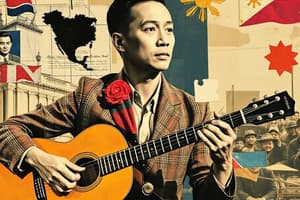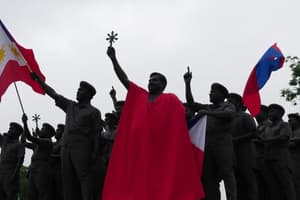Podcast
Questions and Answers
What was the purpose of the national anthem 'Lupang Hinirang' in the post-war period in the Philippines?
What was the purpose of the national anthem 'Lupang Hinirang' in the post-war period in the Philippines?
- To oppose foreign intervention
- To entertain the public with diverse performances
- To promote nationalism (correct)
- To celebrate love and romance
Which law mandates respect for the national anthem 'Lupang Hinirang'?
Which law mandates respect for the national anthem 'Lupang Hinirang'?
- R.A. 10153
- R.A. 8521
- F.A. 9491
- F.A. 8491 (correct)
'Bayan Ko' gained popularity for opposing which form of occupation?
'Bayan Ko' gained popularity for opposing which form of occupation?
- American occupation (correct)
- Japanese occupation
- British invasion
- Spanish occupation
What influence did Bodabil have during the Japanese occupation in the Philippines?
What influence did Bodabil have during the Japanese occupation in the Philippines?
What distinguishes Kundiman from other Filipino music genres?
What distinguishes Kundiman from other Filipino music genres?
Flashcards
What is the national anthem of the Philippines?
What is the national anthem of the Philippines?
"Lupang Hinirang" became the national anthem of the Philippines in 1946. This song, originally composed by Julian Felipe as "Marcha Nacional Filipina", came to be recognized as a symbol of national identity and pride.
Who wrote the lyrics for "Lupang Hinirang"?
Who wrote the lyrics for "Lupang Hinirang"?
The lyrics of "Lupang Hinirang" were written by Jose Palma and symbolize patriotic themes through the Filipino language.
What legislation formalized "Lupang Hinirang" as the anthem?
What legislation formalized "Lupang Hinirang" as the anthem?
In 1962, a revision of "Lupang Hinirang" mandated by F.A. 8491, section 37, formalized its status as the national anthem and emphasized respecting it during performances.
How did "Kundiman" promote nationalism?
How did "Kundiman" promote nationalism?
Signup and view all the flashcards
How did "Bayan Ko" express resistance to American occupation?
How did "Bayan Ko" express resistance to American occupation?
Signup and view all the flashcards
Study Notes
Post-War Philippine Nationalism and Music
- The period from 1946 to the 1970s saw the Filipino national anthem, "Lupang Hinirang," take centre stage in fostering nationalism.
- "Lupang Hinirang" was based on Julian Felipe's "Marcha Nacional Filipina" and Jose Palma's lyrics.
- A 1962 law (F.A. 8491, section 37) mandated respect for the anthem, reflecting its significance.
- The National Historical Institute specified a tempo of ¼ for "Lupang Hinirang," maintaining its march-like character.
- Filipino "kundiman" songs, traditionally considered love songs, also served nationalist purposes.
- "Bayan Ko," from Severino Reyes' "Walang Sugat", criticized American occupation and rose in popularity in 1929.
- During the Japanese occupation, "Bodabil" emerged. Fueled by French vaudeville, it stabilized emotions through performances that influenced musical trends.
Studying That Suits You
Use AI to generate personalized quizzes and flashcards to suit your learning preferences.




